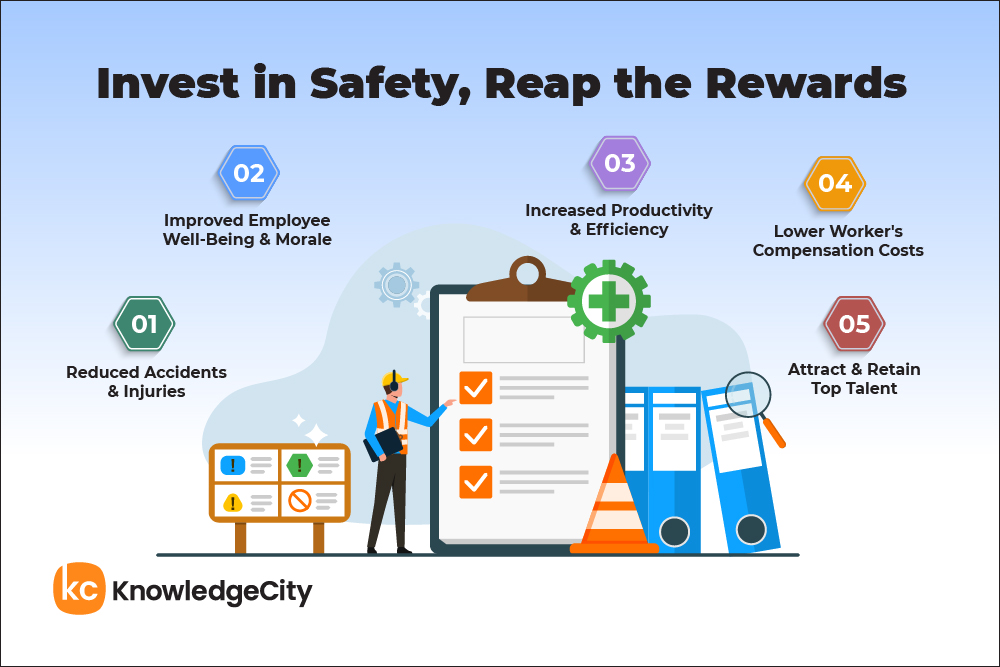Imagine arriving at work each day with the confidence that you’ll return home safe and healthy. That’s the result of a strong safety culture, and effective training programs are the key to achieving it. It’s not just about meeting regulations; it’s about equipping your team with the knowledge and skills to identify and avoid risks. Safety training keeps your employees safe, reduces stress, and promotes a sense of well-being. It also provides peace of mind for employers, knowing they’ve taken every step to protect your team.

However, creating and managing these programs can feel overwhelming. That’s where KnowledgeCity comes in. In this article, we’ll go over best practices, from pinpointing potential hazards in your workplace to tailoring training to your specific needs. By following these steps, you can build a thriving safety culture that empowers your employees, protects your business, and paves the way for a successful future.
The Importance of Safety Training Programs
In today’s workplace, safety shouldn’t be an afterthought— it should be the cornerstone of a healthy and productive environment. But, according to Intertek Alchemy, one of the biggest challenges with ensuring workplace safety is verifying the effectiveness of safety training programs. Effective safety training programs are more than just ticking a regulatory box; they empower employees to become active participants in their own safety and the safety of those around them.
Well-designed safety training programs offer extensive benefits. They instill a sense of security and well-being among employees by equipping them with the knowledge to identify and avoid potential hazards. This confidence enables workers to approach tasks with assurance, knowing they can handle any situation that arises. Moreover, safety training promotes collaboration and teamwork, fostering trust and communication among employees. This collaborative approach not only strengthens the team but also enhances workplace efficiency and productivity.
Financially, robust safety training programs yield undeniable advantages. By significantly reducing the risk of accidents, these programs save companies substantial resources in lost workdays, medical expenses, and potential legal fees. Additionally, effective safety training demonstrates a company’s commitment to employee well-being, attracting and retaining top talent in today’s competitive job market.
Investing in safety training programs is an investment in the workforce, the company, and everyone involved. Prioritizing safety creates a win-win situation where employees feel valued and protected, the company benefits from a healthier and more productive workforce, and everyone can return home safely at the end of the day.
Building and Sustaining a Culture of Safety
Building and sustaining a true culture of safety goes beyond training. It’s about creating an environment where safety is a core value, ingrained in every aspect of the daily work experience. Here’s how to cultivate this vital mindset:
- Leadership Commitment: Safety culture begins at the top. Leaders must vocally champion safety, backing their words with action. Allocate resources for safety training and initiatives, and actively engage in safety discussions and inspections.
- Open Communication: Promote open dialogue about safety concerns. Employees should feel free to report near misses and potential hazards without fear of retaliation. This encourages proactive problem-solving and ongoing improvement of safety protocols.
- Empowerment and Ownership: Empower employees to take charge of their safety and that of their colleagues. Encourage them to identify risks, participate in safety discussions, and contribute to safety protocol development.
- Recognition and Rewards: Celebrate safety successes! Recognize employees who excel in identifying and addressing safety hazards. Positive reinforcement reinforces safe practices and maintains safety awareness.
- Continuous Improvement: A safety culture is never complete. Regularly evaluate safety programs, identify areas for enhancement, and adjust approaches based on feedback and evolving work conditions.
- Integration Into Daily Operations: Safety shouldn’t be an isolated activity. Integrate safety principles into daily work routines, performance evaluations, and company meetings. This ensures safety remains a constant priority, not an afterthought.
- Visible Safety Leadership: Regularly conduct safety walks and inspections. Make safety a regular topic of conversation during team meetings and project discussions. This reinforces the importance of safety and demonstrates leadership’s commitment to providing a safe workplace.
By nurturing a culture of open communication, shared responsibility, and continual improvement, you can establish a workplace where safety is not just a priority but a way of life.
Assessing Organizational Needs for Implementing Safety Training
Before you dive into developing a training program, it’s necessary to assess your organization’s specific needs. This needs assessment helps ensure your training is targeted, relevant, and addresses the most pressing safety concerns within your workplace. Here’s how to conduct a thorough assessment:
- Analyze Your Industry Standards and Regulations: Start by familiarizing yourself with any relevant safety regulations and industry standards that apply to your specific industry and operations. These regulations often outline mandatory training requirements for certain tasks or equipment use.
- Identify Workplace Hazards: Conduct a comprehensive workplace hazard assessment. This can involve walkthroughs, task observations, and consultations with employees to identify potential hazards associated with specific jobs, equipment, and work environments.
- Review Incident History: Analyze past accidents and near-miss reports. This historical data can reveal trends and patterns, highlighting areas where employees might need additional training or where existing safety protocols need improvement.
- Gather Employee Feedback: Employees are your eyes and ears on the ground. Conduct surveys, interviews, or focus groups to gather feedback from your workforce. Ask them about their safety concerns, their knowledge of existing safety procedures, and any areas where they feel additional training would be beneficial.
- Consider Job Roles and Responsibilities: Not all employees need the same safety training. Identify the specific safety needs of each job role within your organization. For example, workers operating heavy machinery will require different training than those working in an office environment.
- Evaluate Existing Safety Programs: Take stock of any existing safety training programs and materials. Are they up-to-date and effective? Are they readily accessible to employees? Identifying gaps in your current programs will help you tailor your new training accordingly.
By conducting a thorough needs assessment, you can gain valuable insights into the specific safety training requirements of your organization.
Evaluating the Impact of Your Current Safety Training Program
Safety training programs are a vital investment in your workforce’s well-being and your company’s overall success. But how do you know if your current program is achieving its goals? Here’s how to evaluate the impact of your safety training program and identify areas for improvement:
- Measure Knowledge Gain: Pre- and post-training assessments are a classic method to gauge knowledge acquisition. These assessments can take various forms, including quizzes, written tests, or practical demonstrations. They help determine if employees grasped the key safety concepts covered in the training.
- Assess Skill Development: Safety training often goes beyond theoretical knowledge. Evaluate if employees can apply the learned skills in real-world scenarios.
Consider role-playing exercises, simulations, or on-the-job assessments to determine if employees can effectively demonstrate the safety practices covered in the training.
- Track Behavioral Changes: The ultimate goal of safety training is to translate knowledge and skills into safe work practices. Monitor changes in employee behavior following the training. Are employees applying the learned procedures more consistently? Are they more likely to identify and report safety hazards? Observing behavior changes provides a strong indication of the training’s effectiveness.
- Monitor Safety Metrics: Accidents and injuries are the ultimate measure of safety effectiveness. Track key safety metrics such as incident rates, near misses, and workers’ compensation claims. A decrease in these metrics following the implementation of a new safety training program suggests a positive impact.
- Gather Employee Feedback: Employees are valuable assets in the evaluation process. Conduct surveys or focus groups to gather feedback on the training program. Was the training content relevant and engaging? Did it provide them with the necessary knowledge and skills to work safely? Employee feedback can highlight areas for improvement and identify gaps in the training program.
- Evaluate Program Engagement: A well-designed and engaging training program is more likely to be effective. Evaluate employee engagement with the training itself. Was the format interesting and interactive? Did it hold their attention and encourage participation? Consider diversifying training methods like incorporating videos, case studies, or group discussions to increase engagement.
Designing Comprehensive Safety Training Programs
Effective safety training programs are the backbone of a strong safety culture. Here’s how to design comprehensive safety training programs that truly make a difference:
- Target Your Audience: Tailor your training to the specific needs of each job role. Office workers will require different training than those operating heavy machinery or handling hazardous materials. Ensure the content directly addresses the hazards and safety protocols relevant to their daily duties.
- Variety Is Key: People learn in different ways. Don’t rely solely on lectures or written materials. Incorporate a variety of engaging training methods to cater to diverse learning styles.
Utilize video demonstrations, interactive simulations, case studies, group discussions, and hands-on practice sessions to keep the training dynamic and effective.
- Make It Relevant and Practical: Focus on real-world application. Connect the dots between safety concepts and everyday work practices. Use relatable scenarios and examples that employees can easily identify with in their daily work environment.
Encourage active participation and discussion. Pose questions, incorporate role-playing exercises, and provide opportunities for employees to ask questions and share their own experiences.
- Keep It Clear and Concise: Avoid overloading participants with information. Present the information in a clear, concise, and easy-to-understand manner. Use visuals, such as diagrams, charts, and infographics, to enhance understanding and retention.
Break down complex topics into smaller, manageable modules. This helps participants absorb the information more effectively and avoid information overload.
- Make It Interactive and Engaging: Encourage active participation. Involve employees in the learning process. Use interactive activities, group discussions, and problem-solving exercises to keep them engaged and motivated.
Incorporate gamification elements, such as points, leaderboards, and friendly competition, to increase engagement and make learning more enjoyable.
- Incorporate Refresher Training: Safety knowledge and skills can deteriorate over time. Schedule regular refresher training sessions to reinforce key concepts and procedures.
Refresher training can also be an opportunity to address any new hazards or changes in safety protocols that may have emerged since the initial training.
- Evaluate and Adapt: Regularly evaluate the effectiveness of your safety training programs. This allows you to identify areas for improvement and adapt your training to better meet the evolving needs of your workforce and workplace.
Managing Safety Training Programs with KnowledgeCity
By following these best practices, you can effectively implement and manage safety training programs in your workplace. Remember, the safety of your employees should always be a top priority, and investing in proper training is a crucial step in ensuring their well-being.
Subscribe to Our Newsletter
Join 80,000+ Fellow HR Professionals. Get expert recruiting and training tips straight
to your inbox, and become a better HR manager.

 KnowledgeCity
KnowledgeCity 










